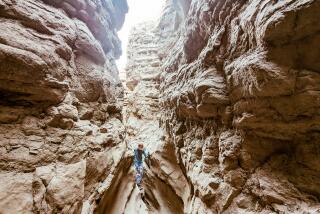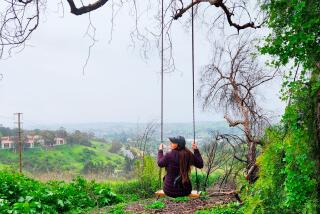Discovering the Mythical Pull of ‘Ramonaland’
For more than a century, the romantic novel “Ramona” has fascinated Southern Californians. Helen Hunt Jackson’s 1884 saga of star-crossed Indian lovers and Spanish/mission customs is the region’s most enduring myth.
Jackson had intended to write an “Uncle Tom’s Cabin” of the mission Indians. Some social critics thought she succeeded, while more conservative Southern Californians were appalled at her portrayal of race, religion and intolerance in their region. However, even dismayed members of the business community changed their points of view when hordes of settlers and tourists from colder climes came to Southern California to see “Ramonaland.”
After the book’s wildly enthusiastic reception came Ramona picture-postcards, pillows, plaques and curios. Chambers of commerce all over Southern California hastened to identify their real locales with the book’s fictional settings, such as “the place where Ramona was wed.”
Ramona’s name endures today on a town, an expressway, an amphitheater and many more locales, so it’s not surprising to find a trail and a camp named for the Indian girl.
Ramona Trail in the San Jacinto Mountains tours classic Ramona country--a pastoral valley opening up to the desert coupled with a dramatic backdrop of pine-covered mountains.
Ramona Trail climbs to a divide where Tool Box Spring offers water and Ramona Camp offers shade. Pack your copy of “Ramona” and read it under the pines.
Directions to trailhead: Drive to Mountain Center, about 20 miles up Highway 74 from Hemet, or a few miles from Idyllwild on Highway 243. From the junction of 243 and 74, proceed southeast on the latter highway 8 miles to the signed Ramona trailhead. Park along the highway.
The hike: Begin at a gate across a dirt road. Pass through the gate and walk along the dirt road 100 yards or so to unsigned Ramona Trail departing from the left side of the dirt road.
The well-engineered path switchbacks gently up the hillside covered with sage, manzanita and red shank. The latter plant, also called ribbonwood for the way its bark peels off in long strips, is the dominant plant on the lower slopes of Thomas Mountain.
Mileage posts stationed every half-mile mark your progress. Enjoy good views of Garner Valley and the Desert Divide area of the San Jacintos.
About 2 miles along, Ramona Trail enters a cool Jeffrey pine forest. A little more than 3 miles from the trailhead, the trail joins a dirt road and almost immediately arrives at Tool Box Spring. Fill your canteen from the water spigot and continue on the dirt road 1/4 mile to Ramona Camp. Tables scattered among the pines suggest a picnic.
Ambitious hikers can join Thomas Mountain Fire Road for the trip to Thomas Mountain.
In 1861, the Charles Thomas family became the first Anglos to settle in this part of the San Jacinto Mountains.
While the dirt fire road offers pleasant, pine-shaded walking, it’s open to vehicles. (Traffic is rare.) Follow the road 1 1/2 miles to a junction, then turn left another half-mile to the summit.
The views of Ramona Country include a look down at Anza Valley.
RAMONA TRAIL
Highway 74 to Ramona Camp, 7 miles round trip, 1,400-foot elevation gain.
Highway 74 to Thomas Mountain, 11 miles round trip, 2,100-foot elevation gain.
More to Read
Sign up for our Book Club newsletter
Get the latest news, events and more from the Los Angeles Times Book Club, and help us get L.A. reading and talking.
You may occasionally receive promotional content from the Los Angeles Times.







